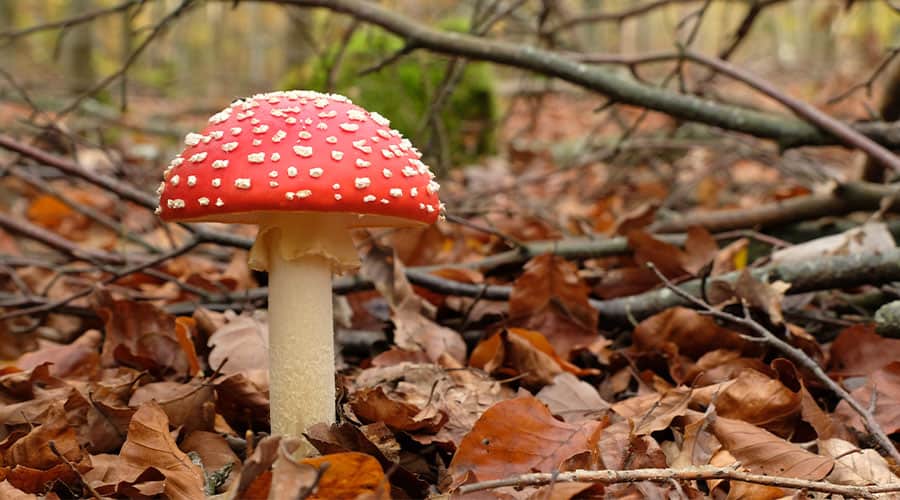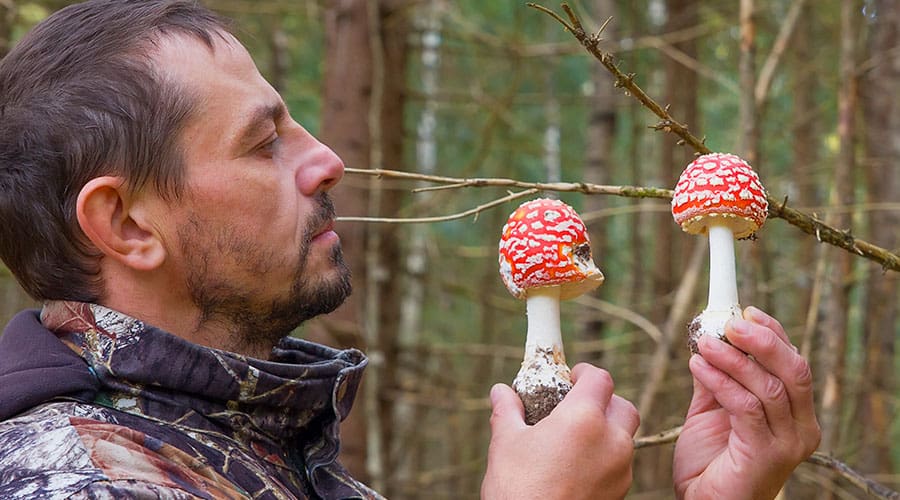Amanita muscaria, with its vibrant red cap coated with white spots, is one of the most instantly recognizable mushroom species on the planet. It is well-known for its psychoactive properties and its use by different cultures throughout time for religious and cultural reasons.
However, apart from the significant role this mushroom species has played in human history, Amanita muscaria continues to play an important ecological role in different ecosystems and food chains. Read on to find out more about this fascinating fungus’s contribution to biodiversity in the natural world.

Why forage for mushrooms when you can have the benefits of Amanita muscaria delivered right to your door? VidaCap’s Amanita muscaria gummies contain 500mg of Amanita extract, and mushroom enthusiasts love them for their delicious flavor and psychoactive effects. Visit VidaCap to order yours today!
Amanita Muscaria Distribution and Habitat
Amanita muscaria is a mushroom species of the wider Amanita genus and Amanitaceae family. Amanita muscaria mushrooms are most commonly found in woodlands in the Northern Hemisphere. However, their widespread presence across many different ecosystems, ranging from boreal and temperate woods to subalpine and alpine landscapes, attests to their adaptability to varied ecological conditions.
Amanita Muscaria’s Role in Mycorrhizal Symbiosis
One of Amanita muscaria’s most important ecological functions is encapsulated in its mycorrhizal role. As a mycorrhizal fungus, Amanita muscaria forms a symbiotic relationship with many different tree species, encompassing conifers and broad-leaved trees.

Simply put, Amanita muscaria and other mycorrhizal fungi effectively act as an extension of the tree’s root system by increasing its absorptive area. This is particularly beneficial for the host tree, as it gains access to essential nutrients, mainly nitrogen and phosphorous.
Significantly, phosphorous supplies are often limited in natural soil. Without the help of Amanita muscaria, the tree would require a vast root system to meet its phosphorous needs. In return, Amanita muscaria benefits from this symbiotic relationship by being supplied with carbohydrates formed during photosynthesis.
Amanita Muscaria’s Important Contribution to Nutrient Cycling
Amanita muscaria plays a pivotal role in the nutrient dynamics of forested ecosystems. By bolstering the extraction of critical nutrients from the soil stratum, Amanita muscaria mushrooms elevate the nutrient profile of its associated flora. This nutritional enrichment extends beyond the host, benefiting surrounding non-mycorrhizal vegetation.
Furthermore, Amanita muscaria indirectly propels nutrient cycling via its reproductive structure. As it undergoes sporulation, organic substances and nutrients are deposited onto the forest substrate. The subsequent decomposition by saprophytic species, i.e., those that feed on dissolved organic material, enriches the soil matrix, fostering the proliferation of diverse plant taxa.
The Biodiversity Impact of Amanita Muscaria Mushrooms
As a mycorrhizal species, Amanita muscaria indirectly steers the prevalence and dispersal of various plant taxa. Many believe mycorrhizal fungi foster plant biodiversity by enabling coexistence through ecological niches.
Moreover, Amanita muscaria‘s periodic fruiting correlates with herbivore behavior. Due to the mushroom’s toxicity, some herbivores evade it, inducing alterations in local herbivorous activities on specific plants associated with this fungus, with subsequent implications for plants in that habitat.
Amanita Muscaria’s Role in the Food Chain
As mentioned, the consumption of Amanita muscaria by herbivores and omnivores is infrequent, mainly due to this mushroom species’ psychoactive compounds. The presence of muscimol and the neurotoxic compound ibotenic acid serves as a potent deterrent against most predators.
However, some animals, such as reindeer and squirrels, have built up a tolerance to Amanita muscaria’s compounds and can consume small doses without adverse effects. The consumption of this mushroom species not only helps to sustain them but also facilitates the propagation of Amanita muscaria spores, seeding new growth in diverse locales.
Insects, including beetles and flies, are attracted by the mushroom’s bright red cap, which produces nectar-like secretions. By feeding on the secretions, these insects play an instrumental role in the translocation of spores, thus ensuring their spread to new regions.
While categorizing these interactions strictly as “mutualistic” might be a simplification, it’s undeniable that they significantly bolster the overall biodiversity of the forest ecosystem. Such intricate relationships between Amanita muscaria and the forest’s fauna underscore the profound interconnectedness of nature, illustrating that even toxic mushroom species can serve an indispensable role in the harmonious functionality of the ecosystem.
Amanita Muscaria as an Indicator of Ecosystem Health
The presence and abundance of Amanita muscaria mushrooms within ecosystems can be symbolic of ecological vitality. Numerous environmental factors, including soil quality, hydration, and arboreal compositions, influence Amanita muscaria’s fruiting cycles.

Monitoring these patterns can offer insights into the ecosystem’s status. For instance, a dwindling presence could signify shifts in soil attributes, like elevated acidity or nutrient depletion, which might reverberate through the forested landscape. In contrast, an uptick in fruiting might denote an uplift in mycorrhizal efficiency and nutrient dynamics.
Amanita Muscaria’s Role in Soil Carbon Sequestration
Contemporary research has embarked on elucidating Amanita muscaria‘s role in carbon immobilization within the soil. Mycorrhizal fungi, such as Amanita muscaria, are instrumental in carbon storage via the synthesis of stable organic compounds, like glomalin-related soil proteins (GRSP). Amanita muscaria and other mycorrhizal fungi preserve soil integrity and boost carbon sequestration.
Challenges and Threats Facing Amanita Muscaria
Despite its ecological centrality, Amanita muscaria confronts some challenges. Anthropogenic disturbances like deforestation and urban expansion disrupt its mycorrhizal networks, endangering its continuity.
Climatic alterations, manifesting in thermal and precipitation shifts, could affect its distribution and reproductive cycles. Further, unbridled extractions of Amanita mucaria mushrooms for recreational or medicinal aims could instigate unsustainable depletions. Sustainable extraction methods and conservation strategies are essential for ensuring its ecological persistence.

Why forage for mushrooms when you can have the benefits of Amanita muscaria delivered right to your door? VidaCap’s Amanita muscaria gummies contain 500mg of Amanita extract, and mushroom enthusiasts love them for their delicious flavor and psychoactive effects. Visit VidaCap to order yours today!
Final Thoughts on The Ecological Importance of Amanita Muscaria in Ecosystems and Food Chains
While renowned for its cultural and psychoactive properties, Amanita muscaria also plays an indispensable role within many ecosystems. Arguably, Amanita muscaria’s most important role lies in its mycorrhizal relationship with several tree species.
Amanita muscaria underscores the intricate interconnections fungi establish within our ecosystems, emphasizing the necessity for a thorough appreciation of biodiversity and the nuanced mechanisms of our natural habitats. However, emerging challenges could potentially threaten Amanita muscaria’s survival and, subsequently, the environmental equilibrium it upholds. Prioritizing sustainable approaches is paramount to preserving this important mushroom species.









